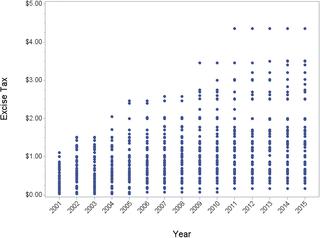PLOS ONE ( IF 3.7 ) Pub Date : 2018-09-20 , DOI: 10.1371/journal.pone.0204416 Michael S Sharbaugh 1 , Andrew D Althouse 1 , Floyd W Thoma 1 , Joon S Lee 1 , Vincent M Figueredo 2 , Suresh R Mulukutla 1

|
Objectives
To provide an up-to-date analysis on the relationship between excise taxes and the prevalence of cigarette smoking in the United States.
Methods
Linear mixed-effects models were used to model the relationship between excise taxes and prevalence of cigarette smoking in each state from 2001 through 2015.
Results
From 2001 through 2015, increases in state-level excise taxes were associated with declines in prevalence of cigarette smoking. The effect was strongest in young adults (age 18–24) and weakest in low-income individuals (<$25,000).
Conclusions
Despite the shrinking pool of current smokers, excise taxes remain a valuable tool in public-health efforts to reduce the prevalence of cigarette smoking.
Policy implications
States with high smoking prevalence may find increased excise taxes an effective measure to reduce population smoking prevalence. Since the effect is greatest in young adults, benefits of increased tax would likely accumulate over time by preventing new smokers in the pivotal young-adult years.
中文翻译:

2001-2015 年卷烟税对吸烟率的影响:使用行为和危险因素监测调查 (BRFSS) 的报告
目标
提供有关美国消费税与吸烟流行率之间关系的最新分析。
方法
使用线性混合效应模型对 2001 年至 2015 年各州消费税与吸烟流行率之间的关系进行建模。
结果
从 2001 年到 2015 年,州级消费税的增加与吸烟率的下降有关。这种影响在年轻人(18-24 岁)中最强,而在低收入个人(<25,000 美元)中最弱。
结论
尽管目前吸烟者人数正在减少,但消费税仍然是减少吸烟流行率的公共卫生努力的一个宝贵工具。
政策影响
吸烟率高的国家可能会发现增加消费税是减少人口吸烟率的有效措施。由于对年轻人的影响最大,增加税收的好处可能会随着时间的推移而积累,通过在关键的年轻人时期防止新吸烟者。



























 京公网安备 11010802027423号
京公网安备 11010802027423号